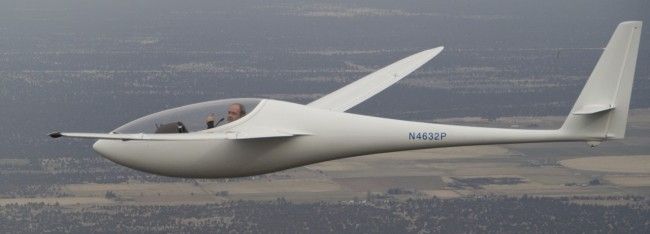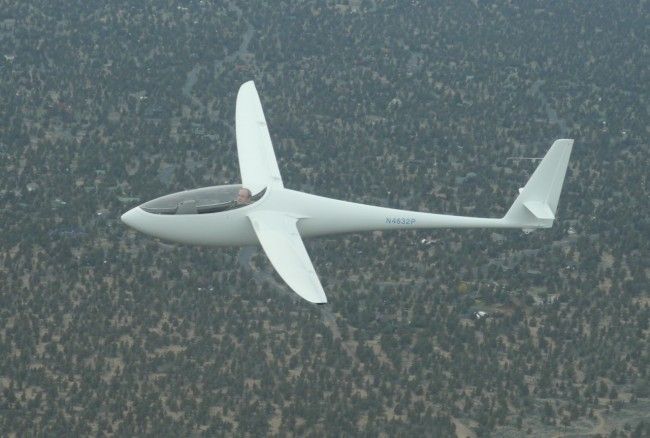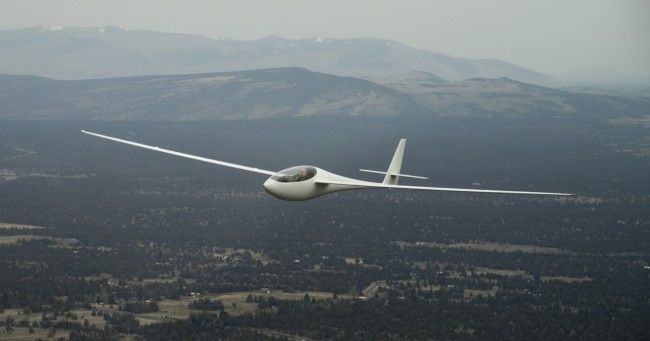In early September, I had a fantastic day of flying at Blairstown Airport, the culmination of which was having the opportunity to fly Windward Performance’s new DuckHawk. I had just flown the club Grob Twin Astir with my brother, promptly falling out and not exactly having one of my best landings in it. It seems that Bill Thar did not see it and upon greeting him, he offered to let me fly the DuckHawk! I was flabbergasted and immediately agreed. The glider was already assembled, so Bill promptly introduced me to the cockpit and gave me a pre-flight briefing. We pushed the glider out to the line, which was easy because at its 440 lbs empty weight, it is just like pushing my club’s 1-26E around!
While I have not flown any high performance single-place gliders before, my many years of flying the Condor Soaring Simulator have allowed me to become familiar with most of the composite sailplanes in the field. I did not feel nervous about being able to control the plane and I was excited to try it out. The first takeoff was very easy and the DuckHawk had great control authority and responsiveness. There was no need for any of the takeoff tricks found on some other sailplanes such as negative flap settings prior to takeoff or open spoilers for increased aileron effectiveness. The visibility was great and it was easy to stay behind the tow plane because the DuckHawk didn’t get thrown around in the turbulence.
Unfortunately, upon releasing I was unable to find much lift except for one light thermal which amounted to zero sink for a while. Pulling into that thermal, it was quite a fantastic sensation bringing the flaps to 10-15 degrees and feeling the glider “grip” the air. The DuckHawk is able to slow down to a tad over 40 knots and provides the pilot with a lot of feedback from the air. What was definitely noticeable was that the glider does everything you want it to. There is no feeling of “fighting the glider” like in some other gliders I had flown. The DuckHawk handled great at the low speed end and the controls were not twitchy, but yet very responsive. I liked the fact that there is no elevator trim; instead wherever one places the stick, it stays in that position. The electric flaps are easily controlled in manual mode using a switch on the stick. The flaps move at a brisk rate, but there is no tendency for the glider to “drop” such as when the flaps are moved between notches in other gliders. This DuckHawk is fitted with a prototype automatic flap control system but it was not used on this flight.
I returned to the field, put the flaps down, and opened the spoilers to land just like you do in other gliders and the nice thing was to put the gear down, I just moved the gated switch and out came the gear. Everything went easily on landing and the floating piston oleo shock is wonderful as there is no bounce and it does its job very nicely and the wheel brake is very effective.
One week later, I took the DuckHawk up for another flight on a day when the ridge was working and had the opportunity to experience this glider’s excellent cross country capability. Since there were thermals present, I had more time to fly the plane and it was a good opportunity to do some stalls and get a feel for the plane throughout more of its envelope.
The stalls were benign and there was very little tendency to drop a wing. The DuckHawk is much like a chameleon in the way it can be thermaled. For instance, at 50 knots it requires very little control to maneuver in a thermal and climbs very well with little effort. However, unlike other sailplanes, this glider really does not seem to have a narrow and sensitive “drag bucket” and as a result, it can be thermaled even down to 40 knots without a significant sink rate penalty.
It was quite interesting that the pilot is given a lot of latitude in how one wants to go about thermaling, which bodes well for different conditions and pilot styles. Prior to the flight, Bill Thar told me that I should consider bringing the glider up to its 160 knots maneuvering speed, which I did after thermaling it for a while. I dived away and got up to around 155 knots and then pulled up, heading like a rocket toward the stratosphere. That pull-up was such a rush that I decided I just had to do it again going the other way! One must also consider that this was done under convective conditions in the vicinity of a ridge, not in smooth air. However, the DuckHawk was absolutely solid and it felt absolutely safe bringing it to a speed that is over the VNE of most other sailplanes.
The plane was flown dry with a light total flying weight around 620 lbs and when I got onto the ridge, I immediately noticed that even for its light weight it did not get particularly kicked around by the dynamic air. Unlike my trusty metal steed (1-26), the DuckHawk seemed to “plow” through the air and handled beautifully on the ridge. The ridge transitions were quite easy and I flew over 400 km at an average speed of 105 mph on the ridge, without doing any turns other than some thermaling practice at the end of “our” mountain. The glider was flown with the prototype automatic/manual flap control system and I think that this will be an exciting system for the future of the plane as the automatic mode smoothly adjusts the flaps throughout their range and gives you the optimum flap setting all the time. The fast roll rate is conducive to rolling in and out very quickly with little adverse yaw. As far as all of the other features of the plane, you can check them out on the manufacturer’s website. It is quite a testament to the design of the glider that someone with as little high performance glider time as I can transition so easily to a world-class racing machine. Windward Performance’s DuckHawk was an absolute delight to fly and it would be an honor to fly it again.
Daniel Sazhin is a junior two Diamond contest pilot who mostly flies at Blairstown NJ, usually in Aero Club Albatross‘ 1-26E “Sweet Red”. Daniel won the 2013 1-26 Championships in Moriarty in his faithful steed. He can also be often found flying in Condor and serving as contest director for a virtual competition called US Nightly Soaring. He is very thankful to all of the people who have helped him over the past eight in his various aviation pursuits.










2 comments for “Having Fun in the DuckHawk 15m Sailplane”